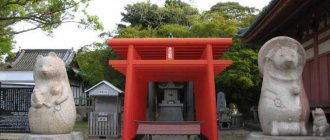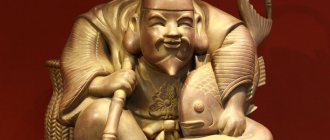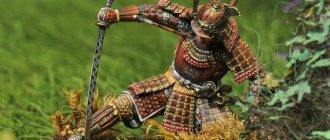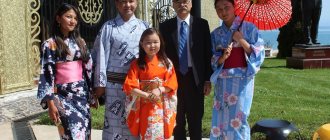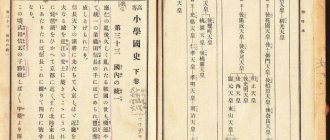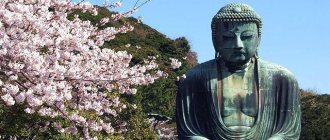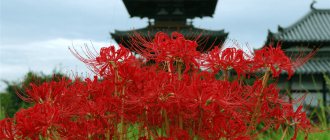Natural conditions: three-layer structure of the Japanese archipelago
The easiest way to explain the Japanese attitude to life and death is to consider the three main aspects that make up the nation's worldview.
Namely: natural conditions, polytheism (especially in comparison with the monotheism of the West) and a fusion of Japanese history and mythology. So, Japanese nature.
One advertising company created an hour-long film showing what Japan looks like from an altitude of 3,000 meters if you fly over it in a Cessna from Okinawa to Hokkaido. This film amazed me. After Okinawa, a huge expanse of sea begins, and flying over the main islands, everywhere you look there are only continuous mountains and endless forests. Among these natural landscapes, rice farming farms, which are traditionally strongly associated with Japanese culture and society, are practically invisible. Our country can rather be called a country of forest and mountain settlements, a sea country.
Then I realized that this landscape was due to the altitude of the flight. What would we see if the Cessna was flying at an altitude of 1000 meters? From this height the vast rice-growing plain of Kanto would be visible. What if you go down to 500 or 300 meters? Then it will be impossible not to notice modern cities and industrial zones.
Then it dawned on me. The Japanese archipelago is a three-layer society: mountain-forest, rice-growing and modern industrial at the same time. This multi-layered structure of the Japanese islands leaves a significant imprint on the nature of our way of thinking and perception. At the deepest level is the Jomon hunter-gatherer culture, at the middle level is the Yayoi rice culture, and at the very surface is modern consciousness and value systems. From such a three-layer structure of landscape and consciousness is born adaptability to the situation, a stoic perception of natural dangers and the senseless deaths associated with them, which we saw in the example of the tragedy of the Great East Japan Earthquake on March 11, 2011.
Famous Japanese physicist and writer Terada Torahiko (1878-1935) in the 1930s. published the essays “Natural Disasters and National Defense” and “Japanese Perceptions of Nature.” In them he wrote that, firstly, as civilization develops, the damage caused by the forces of the elements will increase. Secondly, in Japan, compared to Western Europe, the scale of disasters - earthquakes, tsunamis, hurricanes - is much greater. Thirdly, due to this nature of natural phenomena, humility is born, a readiness not so much to do something in spite of the elements, but to come to terms with it; a lifestyle is developed in which the elements are perceived as a teacher.
As a result of this, Japanese science does not so much strive to change nature as accumulate practical knowledge on how to adapt to it. Here I especially want to draw attention to the fact that if in the West nature is relatively stable, then in Japan, on the contrary, it is quite changeable and often shows its crushing power.
See also[edit]
- Budo
- Giri (Japanese)
- Grace - "itsukushimi"
- Haibutsu kishaku
- Hakk ichiu
- Hermit - for example, Yoshida Kenko, Kamono Chomei
- Kami
- Kokutai
- Ma (negative space)
- Maruyama Masao - "bamboo whisk" culture and "octopus pot" culture
- Nihonjinron
- Disgrace to society
- Wabi Sabi
- Yamato-damashii
- Taoism in Japan
- William Vorilong, one of the first Europeans to gain some knowledge of Japanese philosophy.
The nature of Japan and the frailty of all things
In this general mood of humility before the elements and adaptation to nature, Terada Torahiko reveals the connection of this attitude with the Buddhist concept of the frailty of existence ( mujokan
).
He says that the Japanese, having gone through many trials by natural disasters, feel the “frailty of nature.” This “frailty” ( mujo
) is exactly what Shakyamuni, the founder of Buddhism, was thinking about. There is nothing eternal in this world. Anything that has a form is bound to be destroyed. Any person will die someday - these are the fundamental tenets of Shakyamuni’s teachings.
This Indian teaching underwent significant changes in Japan under the influence of the environment. The feeling of nature that is natural for us is frailty, embodied in rebirth, expressed in the change of seasons and the cycle of existence. Flowers bloom in spring, leaves fall in autumn, and a piercing wind blows from the sea in winter. But with the advent of the new year comes spring. Clear days alternate with cloudy ones, this gives us the strength to live on. From here comes a hardy, calm and gentle attitude towards adversity, and when death approaches, it is accepted calmly, as a return to the earth from which we came, hence the perception of death as a reunification with nature.
CONTENT
- 1 Ancient and medieval thought 1.1 Arrival of Buddhism and early influences in Japan
- 1.2 Kamakura Buddhism
- 2.1 Confucianism
- 3.1 Education and people's rights
"Religion through faith" and "religion through feelings"
A second aspect that can help to understand the Japanese attitude towards life and death is to compare it with the perception of death in monotheistic religions. In 1995 I went to Israel for the first time. There I traveled along the roads that Jesus walked - everywhere you go there is desert, and it makes you feel uneasy. There is a feeling that there is nothing on this earth that would hold you here. It is not enough to simply read the Bible to experience this very special feeling.
I walked along the Jordan, heading towards the holy land of Jerusalem. Suddenly it was revealed to me that the inhabitants of the desert could not help but hope for something unique and extremely valuable somewhere there, in the heavens. They could not help but sincerely believe in one god, located somewhere in the heights, far from this desert land. There was a distinct feeling that without this faith one could not survive a day here. I could not help but come to the conclusion that this is how a religion based on faith is born.
When I was already returning from a trip to Israel, and the plane was approaching the Japanese Islands, it was like a veil fell from my eyes. Spread before me were the greenery of the forests and the endless ocean into which the rivers flowing through the dense forest flow. I spontaneously remembered the gifts of the forests and the sea, as if in reality I heard the cool murmur of rivers and felt the beauty of flowers and herbs that replace each other throughout the year.
I remember the feelings with which the ancient poets wrote, whose poems were included in the collection “Manyoshu” (“Collection of Myriad Leaves”); It’s as if you feel on your skin the breath of your ancestors who spent their lives in the forests. Any living creature feels calm on this earth, and there is no need to imagine some unique value somewhere out there, in the heavens. Forests, mountains and valleys are filled with a sense of the presence of deities, echoing with the voices of Buddhas and Bodhisattvas. Is this why polytheism appeared on the Japanese islands as a religion based on feelings and sensations?
Bibliography[edit]
Lyrics
- James W. Heisig, Thomas P. Kasulis, John C. Maraldo (eds.), Japanese Philosophy: A Handbook
, Honolulu: University of Hawaii Press, 2011. - David A. Dilworth and Waldo J. Viglielmo, with Agustin Jacinto Zavala (eds.), Handbook of Contemporary Japanese Philosophy: Selected Documents
, Westport: Greenwood Press, 1998. - R. Tsunoda, W. T. de Bary, D. Keene (eds.), Sources of Japanese Traditions
, New York: Columbia University Press, 1964, 2 vols.
Research
- H. Gene Blocker, Christopher L. Starling, Japanese Philosophy
, Albany, NY: State University of New York Press, 2001. - Hajime Nakamura, History of Japanese Thought: 592–1868.
Japanese Philosophy Before Western Culture Entered Japan , London–New York: Kegan Paul, 1969. - Gino C. Piovesana, Modern Japanese Philosophical Thought
, New York: St. John's University Press, 1969.
"Personality" and "person"
One can probably talk about the opposite nature of religions based on faith and on sensations. The borrowed word ko, “separateness,” is perhaps best suited to describe the feelings of a person living by faith. In other words, every single person believes in the existence of a higher value in the otherworldly heavenly world. Isn’t this where the concepts of “personality” and “individuality” originated?
However, in the case of religions based on sensations, as I notice, the Japanese word hitori
, "one man". For more than a thousand years, we can observe legends and stories about this man - from “one man”, burdened by loneliness in the wilderness, through whileing away the night alone and sadness in the awareness of his insignificance - to “one man”, whose self-awareness extends to the entire Universe, becoming part of her self-awareness.
Compared to the concept of “personality,” which was borrowed from Europe in modern times, the meaning of the Japanese word “person” is much deeper and broader. And this idea of a person is inextricably linked with the feeling of the frailty of existence, characteristic of the inhabitants of the Japanese islands, which I have already spoken about.
Shinto-Buddhist syncretism and the emergence of state Shinto
It is worth noting one more feature of the religion that appeared in Japan, based on sensations. It lies in the fact that a system of coexistence of a foreign religion, Buddhism, and native Japanese Shinto has developed, forming the phenomenon of Shinto-Buddhist syncretism. The essence of deities in Shinto is significantly different from what is called “God” in Christianity, because Japanese Shinto deities were represented as spirits living in mountains, forests and valleys, rivers and seas; as entities living in nature itself. They have no personality or body as such. Many were not even given their own name, being presented as deities with the spiritual power to inhabit anything. Therefore, there is a strong tendency to call them conventionally in the plural - kamiga
, i.e. “gods of Shinto”. With the advent of Buddhism, a period of coexistence and separation of spheres of influence of the two religions begins.
Shinto deities began to be perceived in a Buddhist vein, and for some time now the name Shinbutsu-shugo
(in Russian-language religious literature the term “Shinto-Buddhist syncretism” was established). Interestingly, in the process of repeated mixing of the two religions, the deity and the Buddha in the resulting syncretic Shinto-Buddhist system became almost indistinguishable.
With the advent of the Meiji period, Christianity became officially introduced in Japan. The perception of Japanese deities is influenced by Christianity, and along with the formation of the new Japanese statehood, monotheistic cults arose in Meiji. Their essence was that one of the Japanese deities was chosen and revered as the supreme deity. This is how state Shinto appears.
Thus, the cults of mountain, sea, river and field deities were first influenced by Buddhism and then Christianity, and the Japanese religion began to resemble a three-story temple. And here I would like to draw attention to the fact that this structure corresponds to the three-layer structure of the Japanese consciousness, which I spoke about above.
At the same time, under the influence of Buddhism that came from abroad, one important change occurred. I would like to note it as very important for understanding the Japanese attitude towards life and death. The word “Buddha” in India was used to describe a person who engages in Buddhist practice and achieves Nirvana.
After this word came to Japan, under the influence of Shinto it acquired a new meaning - the deceased person began to be called “Buddha”. In Shinto, it was believed that the deceased becomes a deity. There is no need to go far - in our modern society no one doubts that a deceased person can be called a Buddha. The Japanese took the Indian word "Buddha" in its original sense, but at some point in Japan the word became a posthumous designation for any person.
Early modern thought
Further information: Edo period
While ancient and medieval thought in Japan was closely associated with Buddhism, early modern thought about Japan was primarily Confucianism or Neo-Confucianism, which was intended for official study by the Tokugawa shogunate. In addition, rational Confucianism stimulated Kokugaku, Rangaku, and unofficial popular thought after the middle Edo period.
Confucianism
Main article: Neo-Confucianism in Japan
During the Edo period, Confucianism was an authorized study. Various schools of Neo-Confucianism were popular.
The Zhu Xi school of Neo-Confucianism respected the family-like feudal order that left in place fixed social positions. Hayashi Razan believed that the Zhu Xi school of Neo-Confucianism was the theoretical basis of the Tokugawa shogunate. Through the principle of civil government, Yushima Seido was founded, dedicated to Confucius. By the Kansei reforms, the Zhu Xi school of Neo-Confucianism was further strengthened and sanctioned by the Tokugawa shogunate. In addition, the idea of Zhu Xi's school of Neo-Confucianism greatly influenced the political movement advocating honoring the emperor and expelling foreigners in the late Tokugawa era.
Unlike Zhu Xi's school of Neo-Confucianism, Wang Yangming's school of Neo-Confucianism, which respects practical ethics, was constantly monitored and suppressed by the Tokugawa shogunate due to its criticism of the socio-political conditions under the Tokugawa shogunate.
Third schools of Neo-Confucianism took into account the true intentions of the original texts of Confucius and Mencius. Yamaga Soko based his philosophy on Confucian ethics and considered the samurai to be the highest class. Ito Jinsai paid attention to the "ren" of Confucius, and he respected "ren" as love for another person and "truth" as a pure consideration. In addition, drawing on his extensive studies of the ancient Chinese classics, Ogyu Sorai insisted that the original Confucian spirit should rule the world and save the citizen.
Kokugaku and Rangaku
Main articles: Kokugaku and Rangaku
During the mid-Edo period, kokugaku, the study of ancient Japanese thought and culture, became popular in relation to foreign ideas such as Buddhism or Confucianism. Under the Sakoku policy of the Tokugawa shogunate, Edo intellectuals could not have any positive contact with Western civilization, and so Rangaku, who studied in Dutch, was the only window to the West.
In the middle of the Edo period, Kokugaku became popular, influenced by positivist Confucianism with nationalism as a background. Kokugaku positively studied ancient Japanese thought and culture, including the "Kojiki", "Nihon Shoki" and "Man'yōshū", and they sought to unearth Japan's original moral culture, which was different from Confucianism and Buddhism. Kamo no Mabuchi struggled with the study of "Manyoshu" and called "masurao-buri" for its masculine and tolerant style, and he praised the collection as pure and simple. Thanks to his study of Kojiki
Motorite Norinaga argued that the essence of Japanese literature came from the "no mono unknown" which were natural feelings that arise when you connected with an object. He respected the Japanese "Yamato spirit" instead of the Chinese (Confucianism/Buddhism) "kara spirit". According to him, Kokugaku should stick to the old Japanese "Shinto" style. While studying Kokugaku, Hirata Atsutane advocated nationalistic state Shintoism, obedience to the Emperor, and the abolition of Confucianism and Buddhism. It was the driving force towards the end of the Tokugawa shogunate and the Meiji Restoration.
There was no direct contact with the West during the Sakoku period of the Edo period, but Rangaku became popular by encouraging the import of Western books translated into Chinese from China during the Kyūhō reforms. Maeno Ryotaku and Sugita Genpaku translated the Dutch Tafel Anatomy into Japanese. Towards the end of the Tokugawa era, the study of Dutch expanded into other Western studies such as British, French and American studies. The image of "Japanese spirit, Western civilization" was completed by Sakuma Shozan's direct expression "Eastern ethics and Western technology." Because Takano Chōei and Watanabe Kazan severely criticized Sakoku, they were oppressed by the Tokugawa shogunate.
Popular thought
During the Edo period, private schools were opened by samurai, merchants, and scholars who played an active role. Their thoughts were criticism of the prevailing feudal system.
Ishida Baigan synthesized Confucianism, Buddhism and Shintoism and founded a practical philosophy for the masses. He recommended working hard for commerce as an effect of honesty and frugality. Ando Shuki called the natural world an ideal society in which all people were engaged in agriculture and lived self-sufficiently, without artificiality. He criticized a legal society in which there was class-feudal discrimination and a distinction between rich and poor. Ninomiya Sontoku insisted that people should pay for the virtues that support their existence with their own virtue.
Japanese identity in history and myths
The third approach to understanding the essence of the Japanese perception of religion is to understand the special attitude of the Japanese to myths and history. As we know, the ancient myths and history of the Greeks and Romans originated from different sources. That is, what is described in the myths of the Greeks and Romans, those events that Herodotus and Thucydides write about, could not be perceived in a coherent sequence. This is well known in Western religious studies and historical science.
However, a completely different relationship exists between ancient Japanese myths and historical records. This is due to the fact that the emergence of the gods and the formation of the human world were perceived as one whole, and therefore the historical perception of the emergence of the state and its origins was completely different from that of Western peoples.
As we know from the Kojiki and Nihon Shoki myths, in the world described there there are two types of deities. These are deities who live forever and deities who are venerated in imperial tombs. They can be defined as eternal and transitory deities. About the first we can say that these are heavenly deities, amatsukami
, and they live in the High Sky Plain,
Takamagahara
.
The latter include earthly deities, kunitsukami
, who are the descendants of the former.
Heavenly deities may disappear from this world, but they do not die. But their descendants, earthly deities who descended to earth, along with their descendants, on the contrary, are mortal and are revered in their graves. Emperor Jimmu, the founder and first emperor of Japan, was one such deity. We can say that this is how the relationship was established between deities who are born and die, and people who are also born and die. The myth thus entered a historical phase and was not interrupted.
From here, the origins of the ceremony of rebuilding the Ise-jingu shrines dedicated to Amaterasu, held in the fall of 2013, become well understood. It is held every 20 years, the sanctuaries are rebuilt anew, and the deity moves from the old sanctuary to the new one. It seems to me that the meaning of this is that the “old” deity dies, being reborn in the “new” one, which takes up residence in the new sanctuary. This is a ceremony dedicated to the death and rebirth of a deity.
Deities, like people, die - the appearance of this thought allows the myth to become a story based on a general attitude and perception of life and death, and from here the perception of man is born. From here, from the understanding of the transient nature of deities, comes a deep awareness of the frailty of life.
Western gods in the flesh and disembodied deities of Japan
So, the belief system in whose myths the Japanese kami deities appear belongs to polytheism. Indeed, this is precisely what should be called a world where myriads of gods operate. However, upon closer inspection, this polytheistic belief in “myriad gods” is not exactly the same as it was in Greece and Rome. It also differs from Indian Hinduism and Chinese Taoism.
If we get rid of the obvious differences, then the deities in these “myriad gods”, in comparison with other religions, have much less manifested expressions of physicality and individuality. They are, so to speak, invisible deities. As I said above, the gods of the Japanese islands are contained in the seas, mountains, rivers and valleys themselves. As for the Western, Greco-Roman gods - even old Zeus, even young Apollo, even young Cupid have individual bodily qualities. The same applies to the supreme deities of Hinduism - Vishnu and Shiva. Perhaps we can say that all of these gods have individual physical characteristics and represent pantheons of gods that can be seen and described.

